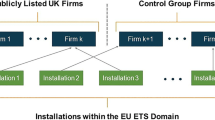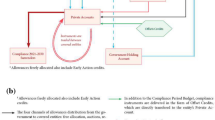Abstract
In a model inspired by the EU Emissions Trading Scheme, non-cooperative countries allocate their emissions to internationally trading and non-trading sectors. Each country is better off with trading than without, and aggregate welfare is maximized with all sectors in the trading scheme. We analyze the effects of extending the sectoral coverage of the trading scheme in a two-country model with quadratic abatement costs. If only the original trading sector is asymmetric between countries, the welfare change is always positive and the same in both countries. If the original and additional trading sectors are asymmetric, one country might lose, but there is an aggregate welfare gain. If the original trading sector and the non-trading sector are asymmetric, both countries always gain.
Similar content being viewed by others
References
Armstrong CW (2008) Using history dependence to design a dynamic tradeable quota system under market imperfections. Environ Resour Econ 39: 447–457
Babiker M, Reilly J, Viguier L (2004) Is international emission trading always beneficial?. Energy J 25(2): 33–56
Bernard A, Vielle M, Viguier L (2004) Modeling the European Directive establishing a scheme for greenhouse gas allowance trading and assessing the market power of firms. REME working paper, École Polytechnique Fédérale Lausanne
Betz R, Sanderson T, Ancev T (2010) In or out: efficient inclusion of installations in an emissions trading scheme?. J Regul Econ 37: 162–179
Bhagwati JN, Panagariya A, Srinivasan TN (1998) Lectures on international trade, 2nd edn. MIT Press, Cambridge
Böhringer C, Rosendahl KE (2009) Strategic partitioning of emission allowances under the European Union Emission Trading Scheme. Resour Energy Econ 31: 182–197
Böhringer C, Koschel H, Moslener U (2008) Efficiency losses from overlapping regulation of EU carbon emissions. J Regul Econ 33: 299–317
Capros P, Mantzos L (2000), The economic effects of EU-wide industry-level emission trading to reduce greenhouse gases: results from PRIMES Energy Systems Model, E3M Lab. Institute of Communication and Computer Systems of National Technical University of Athens
Convery FJ (2009) Origins and development of the EU ETS. Environ Resour Econ 43: 391–412
Convery FJ, Redmond L (2007) Market and price developments in the European Union Emissions Trading Scheme. Rev Environ Econ Policy 1: 88–111
Copeland BR, Taylor MS (2005) Free trade and global warming: a trade theory view of the Kyoto Protocol. J Environ Econ Manag 49: 205–234
Dijkstra BR, Manderson M, Lee T-Y (2008) Partial international emissions trading, GEP Research Paper 2008/27, University of Nottingham
Ehrhart K-M, Hoppe C, Löschel R (2008) Abuse of EU emissions trading for tacit collusion. Environ Resour Econ 41: 347–361
Eichner T, Pethig R (2009) Efficient CO2 emissions control with emissions taxes and international emissions trading. Eur Econ Rev 53: 625–635
Ellerman AD, Buchner BK (2007) The European Union Emissions Trading Scheme: origins, allocation, and early results. Rev Environ Econ Policy 1: 66–87
Ellerman AD, Buchner BK (2008) Over-allocation or abatement? A preliminary analysis of the EU ETS based on the 2005–06 emissions data. Environ Resour Econ 41: 267–287
Ellerman AD, Schmalensee R, Joskow PL, Montero J-P, Bailey E (2000) Markets for clean Air: the US acid rain program. Cambridge University Press, Cambridge
EU (2009) Directive 2009/29/EC of the European Parliament and of the Council of 23 April 2009 amending Directive 2003/87/EC so as to improve and extend the greenhouse gas emission allowance trading system of the Community. Available at http://eur-lex.europa.eu/LexUriServ/LexUriServ.do?uri=OJ:L:2009:140:0063:0087:EN:PDF
Hagem C, Westskog H (2009) Allocating tradable permits on the basis of market price to achieve cost effectiveness. Environ Resour Econ 42: 139–149
Hahn RW (1984) Market power and transferable property rights. Q J Econ 99: 753–765
Helm C (2003) International emissions trading with endogenous allowance choices. J Public Econ 87: 2737–2747
Johnson HG (1953–1954) Optimum tariffs and retaliation. Rev Econ Stud 21:142–153
Kruger J, Oates WE, Pizer WA (2007) Decentralization in the EU Emissions Trading Scheme and lessons for global policy. Rev Environ Econ Policy 1: 112–133
Maeda A (2003) The emergence of market power in emission rights markets: the role of initial permit distribution. J Regul Econ 24: 293–314
Malueg DA, Yates AJ (2009a) Strategic behaviour, private information, and decentralisation in the European Union Emissions Trading Scheme. Environ Resour Econ 43: 413–432
Malueg DA, Yates AJ (2009b) Bilateral oligopoly, private information, and pollution permit markets. Environ Resour Econ 43: 553–572
Syropoulos C (2002) Optimum tariffs and retaliation revisited: how country size matters. Rev Econ Stud 69: 707–727
Westskog H (1996) Market power in a system of tradeable CO2 quotas. Energy J 17: 85–103
Author information
Authors and Affiliations
Corresponding author
Rights and permissions
About this article
Cite this article
Dijkstra, B.R., Manderson, E. & Lee, TY. Extending the Sectoral Coverage of an International Emission Trading Scheme. Environ Resource Econ 50, 243–266 (2011). https://doi.org/10.1007/s10640-011-9470-1
Accepted:
Published:
Issue Date:
DOI: https://doi.org/10.1007/s10640-011-9470-1




